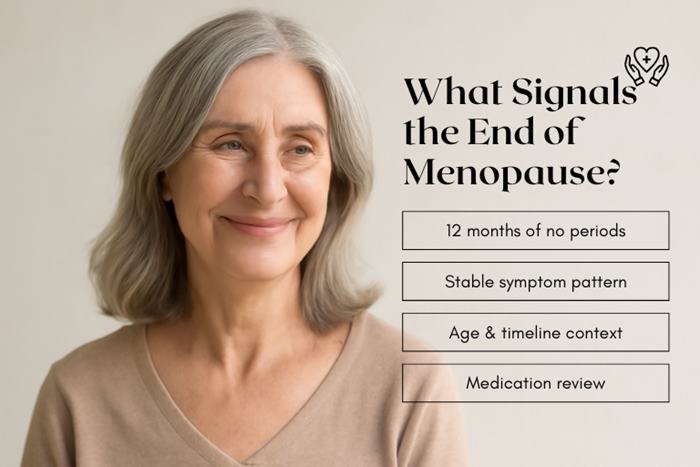What Signals the End of Menopause? Signs, Tests & Post-Hysterectomy Considerations
By Editorial Health Team • Reviewed by board-certified clinicians
Education only. Not a substitute for medical advice.
Quick definition
Menopause is officially reached after 12 consecutive months without a menstrual period not explained by pregnancy, medication, or illness. The time after that point is the postmenopause phase. When people ask “what signals the end of menopause?”, they are usually looking for reliable indicators that the transition from perimenopause to postmenopause is complete.
Core signals menopause has ended
- 12 months of no periods (natural cycles):
If you still have a uterus and are not on hormonal birth control, no bleeding for a full year is the gold-standard clinical marker that menopause has passed and you are now postmenopausal. - Stable symptom pattern:
Vasomotor symptoms (hot flashes, night sweats) often decrease in frequency/intensity over time. While not a perfect signal, a trend toward fewer episodes can indicate you’re well into postmenopause. - Age & timeline context:
For most people, natural menopause occurs between ages 45–55. If you are in this range and have had 12 months of amenorrhea, that strongly supports that menopause has ended. - Medication review:
If you use hormonal contraception or hormone therapy, withdrawal bleeding can mask timing. Your clinician may guide a pause or targeted testing to clarify status.
| Signal | What it suggests | How reliable? |
|---|---|---|
| 12 months with no periods | Postmenopause has begun | High (if not on hormones) |
| Declining hot flashes | Transition is stabilizing | Moderate (varies widely) |
| Fewer PMS-like symptoms | Ovarian activity has ceased | Low–Moderate |
| FSH persistently elevated | Ovarian reserve depleted | Moderate (context-dependent) |
Can tests confirm the end of menopause?
Lab tests may support the picture, but they rarely replace the 12-month rule. Two common markers:
- FSH (follicle-stimulating hormone): Persistently high FSH (commonly >30–40 IU/L) with low estradiol suggests ovarian shutdown. However, FSH can fluctuate, so one reading is not definitive.
- Estradiol (E2): Low levels support postmenopause but must be interpreted alongside symptoms, age, medications, and cycle history.
Bottom line: tests support the diagnosis; your bleeding pattern and clinical context remain primary.
Symptoms that typically fade—and those that may persist
Many people notice a gradual easing of vasomotor symptoms over several years after the final period. Sleep and mood often stabilize. However, some changes—such as vaginal dryness, reduced skin elasticity, and shifts in cholesterol or bone density—may persist and deserve ongoing care.
- Often improve: hot flashes, night sweats, cycle-linked migraines, cyclic breast tenderness.
- May persist: vaginal dryness, discomfort with intercourse, recurrent UTIs, bone loss, metabolic changes.
Evidence-based options (e.g., vaginal estrogen, non-hormonal moisturizers/lubricants, lifestyle changes, bone health screening) can help—discuss with your clinician.
What signals the end of menopause after hysterectomy?
Determining what signals the end of menopause after hysterectomy depends on the type of surgery:
- Hysterectomy with both ovaries removed (bilateral oophorectomy):
Menopause occurs immediately after surgery. The “end” of the transition is marked by the abrupt stop of ovarian hormone production; symptoms may begin within days to weeks. - Hysterectomy with ovaries preserved:
You won’t have periods, so the 12-month rule doesn’t apply. In this case, clinicians look to age, symptoms (e.g., onset and trajectory of hot flashes), and sometimes serial labs (FSH/estradiol) to infer that ovarian function has ceased and you are postmenopausal.
Practical approach: track vasomotor symptoms and discuss whether targeted lab testing or a short “hormone holiday” (if on therapy) is appropriate to clarify status.
Real-life examples (for clarity)
Example A (natural cycles): Jamie, 52, has had no period for 13 months without hormone therapy. Hot flashes have decreased from daily to once weekly. This pattern strongly indicates that menopause has ended and Jamie is postmenopausal.
Example B (hysterectomy, ovaries intact): Priya, 49, had a hysterectomy at 45 but kept her ovaries. At 49 she develops frequent night sweats and hot flashes. Two FSH tests several months apart are elevated with low estradiol. Together, these signal that she has transitioned into postmenopause despite the absence of bleeding.
Example C (surgical menopause): Rosa, 42, had both ovaries removed for medical reasons. She experiences abrupt hot flashes and sleep disruption within two weeks—consistent with immediate menopause after oophorectomy.
Self-checklist: are you likely postmenopausal?
- You are 12+ months without a period (and not on hormonal contraception or therapy).
- Your hot flashes/night sweats have stabilized or are slowly decreasing.
- You are in the typical age range (mid-40s to mid-50s) or had both ovaries removed.
- If you had a hysterectomy with ovaries preserved, symptoms plus supportive labs suggest ovarian function has ceased.
FAQs
Is one blood test enough to say menopause has ended?
Usually not. FSH and estradiol fluctuate. Clinicians often repeat tests and interpret them with age, symptoms, and medication use.
Can hormone therapy hide the end of menopause?
Hormone therapy and some contraceptives can mask bleeding and alter labs. Your clinician may adjust therapy or test strategically to clarify status.
Do hot flashes always stop once menopause has ended?
No. Many people improve over time, but some continue to have symptoms for years. Effective treatments are available.
What about what signals the end of menopause after hysterectomy if I’m 55+?
At ages 55 and above, sustained vasomotor symptoms plus persistently high FSH/low estradiol strongly suggest postmenopause, even without bleeding.
When to see a clinician
Seek care if you have unexpected bleeding after 12 months of no periods, severe or worsening symptoms, or concerns about bone, heart, or sexual health. Personalized evaluation ensures safe, effective care.

